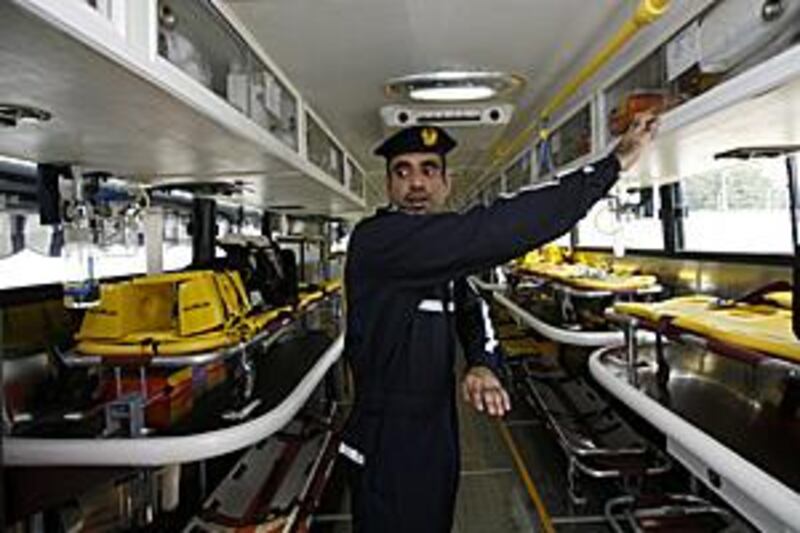If you never see the pride of the Abu Dhabi Police Department's Paramedic Division, count yourself lucky. For large-scale emergencies, the emirate has a fleet of seven bus ambulances, the only ones of their kind in use in the Middle East. Manufactured by Mercedes-Benz's Jordanian affiliate, Elba, each is capable of carrying up to 20 patients and a crew of seven doctors, paramedics and nurses. They cost between Dh2 million and Dh3 million each.
"We cannot tell you exactly how much the buses cost, but Abu Dhabi was able to acquire these buses at a huge discount from the manufacturer. But no matter what they cost, they are worth the expense, as a single human life is worth more," said Lieutenant Lutfi Bouka, who along with Major Abdullah Awad were responsible for overseeing the manufacturing of the buses in Jordan, designing the interior and equipping them with a full gamut of life-saving equipment.
Inside the bus The National visited were 16 beds and four chairs that can be inclined, allowing the treatment of a total of 20 people. The buses are fully equipped with oxygen cylinders, gurneys, a generator, an incubator and up to six defibrillators. Other models are fitted with a mobile field laboratory and one fitted with equipment allowing for minor surgeries to be performed. As is customary with any emergency vehicle, the buses are equipped with flashing headlights, two light bars and sirens.
All seven buses have a hydraulic ramp and have an extendable awning to provide shade for patients and medical personnel. "Everything that can be done in an ambulance can be done on these buses," says Lieutenant Bouka. "They have proven to be a valuable tool. If we did not have these buses we would have to dispatch between 10 and 20 ambulances. Having this fleet helps free up the GMC ambulances for more urgent cases."
Powered by a rear-mounted, turbocharged, six-cylinder diesel engine producing 360-horsepower, the buses are capable of travelling at speeds of 120 kilometres per hour. The vehicles weigh more than 18,000 kilograms, making them slower and less manoeuvrable than the smaller GMC ambulances capable of carrying two patients. That means Abu Dhabi's infamous parking problems can be a major obstacle for them.
"The operators of the buses face the same challenges as the operators of fire lorries," Lt. Bouka said. "Before leaving for areas we know to be crowded, we advise operations that we are en route so that the route can be cleared for us. "We know which are the best routes to take so that the bus does not lose time in traffic while responding to the scene of a major incident." According to Lieutenant Mohammed Ibrahim Jafar, the buses have been used numerous times.
"The true test of the buses came in March last year, when 200 cars were wrecked in the fog at Ghantoot injuring around 277 people," Lt. Jafar said. "We dispatched the buses from Abu Dhabi and they arrived on the scene within 30 minutes." "Patients in critical condition were treated and stabilised on the buses, then rushed to hospital by smaller ambulances capable of navigating through traffic quickly. For those suffering minor to moderate injuries, they were transported on the bus," he said.
The Abu Dhabi Police uses the bus ambulances for emergencies throughout the UAE and have used them in Dubai in March of last year when a major fire erupted in the Al Quoz Industrial Zone. "We received orders to help the Dubai authorities and immediately dispatched a bus there," Lt. Bouka said. "We also have the buses on standby whenever there is an event that thousands of people attend, like football matches."
The buses were used again on the Abu Dhabi to Dubai motorway when a bus overturned, injuring more than 20 passengers. In the event that a major fire breaks out and civil defence personnel have to remain on scene for a number of hours, a bus is dispatched in order for fire personnel to rest on it, be hydrated and if need be provided oxygen, as was the case when a major fire broke out on Airport Road on top of a high-rise building last September.
During that incident, the Abu Dhabi emergency services responded with a number of fire engines, ambulances, two helicopters and one of the mass-casualty, 20-patient ambulance field hospital buses. "These buses are stationed in Abu Dhabi, Mafraq, Al Ain, Shahama, the western region and other areas of Abu Dhabi," Lt. Jafar explains. "They are distributed throughout the emirate so as not to be far from any location where they may be needed. Fortunately Abu Dhabi is a safe emirate with relatively few mass casualty incidents so the buses are not in use everyday.
"But they are always on standby." ealghalib@thenational.ae






